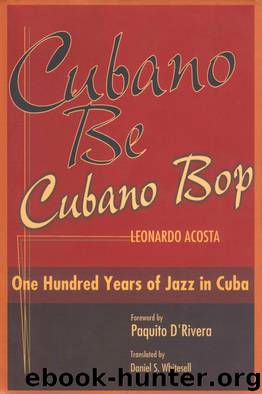Cubano Be, Cubano Bop by Leonardo Acosta

Author:Leonardo Acosta [Acosta, Leonardo]
Language: eng
Format: epub
ISBN: 978-1-58834-547-9
Publisher: Smithsonian
Published: 2006-06-20T16:00:00+00:00
In 1952 the pianist, composer, and arranger Bebo Valdés started what could be considered a musical revolution similar to the one that Machito and Mario Bauzá began in New York or Dámaso Pérez Prado had begun in Mexico. Nevertheless, what would have been the batanga rhythm revolution remains as only an interesting historical curiosity and a pleasant memory for those that lived it. Bebo, pianist and arranger of Armando Romeu’s band and deeply involved in the feeling movement, seemed the perfect man to bring about a new fusion between jazz and Afro-Cuban music, surpassing the growing commercialization of mambo and the limitations of chachachá. In his musical conceptions, Bebo was very similar to Niño Rivera, and both had spent years experimenting with new rhythmic and orchestral combinations. If El Niño had to his credit numbers such as “El Jamaiquino” and “Atomo,” Bebo had composed “Rareza del siglo,” “Daiquirí,” “Copla guajira,” “Ritmando el chachachá,” and above all “Güempa,” a mambo that became very popular. As usual with mambos, this one had only a sung theme for eight measures and the rest was instrumental, but with no room for soloists. It also didn’t offer substantial rhythmic changes. These would come with batanga and the orchestra that Bebo organized to play it.
Two years before, when the band of Pérez Prado was at Channel 4 and the Sans Souci cabaret, one night we took our Mexican friends to hear the Tropicana orchestra. After the set was over we sat down to talk and they asked Bebo Valdés his opinion on Pérez Prado’s band. Bebo responded that his ear was telling him that a trombone section would be good to fill the vacuum between the high and low timbres that Damaso’s orchestrations created. And this is what he did with batanga from the orchestral point of view, including three trombones and a French horn, an unusual instrument in jazz bands. And there were, of course, new rhythmic combinations introduced in Cuban percussion, where for the first time a batá drum was used within a new rhythm. Bebo Valdés along with his orchestra and his batanga rhythm were presented in a special program on the radio station RHC Cadena Azul Sundays in the afternoon and later during evening hours, and recordings were made of some programs, although only on recording tape, which were never made into records to be sold on the market. The orchestra that Bebo formed had a number of musicians from Armando Romeu’s band, starting naturally with Bebo himself. The impressive lineup was the following: trumpets: Nilo Argudín, Dagoberto Jiménez, El Negro Vivar, Chocolate Armenteros, and Pedro Rodríguez; trombones: Alberto Martí, Generoso Jiménez, and Miguel Reina; French horn: Víctor del Castillo; saxophones: “El Cabito” Quesada and Roberto Sánchez (altos), Gustavo Más and Ñico Romero (tenors), and Diego “Bebo” Loredo (baritone). The rhythm section featured Bebo Valdés (piano), Kiki Hernández (bass), Guillermo Barreto (drums), Rolando Alfonso and Arturo Linares (“Hueso”) on congas, Trinidad Torregosa on batá drum, and the singers “El Indio” Cruz and Ezequiel Cárdenas.
Download
This site does not store any files on its server. We only index and link to content provided by other sites. Please contact the content providers to delete copyright contents if any and email us, we'll remove relevant links or contents immediately.
Aircraft Design of WWII: A Sketchbook by Lockheed Aircraft Corporation(32187)
The Great Music City by Andrea Baker(31246)
Call Me by Your Name by André Aciman(20347)
The Secret History by Donna Tartt(18803)
The Art of Boudoir Photography: How to Create Stunning Photographs of Women by Christa Meola(18500)
Shoot Sexy by Ryan Armbrust(17633)
Plagued by Fire by Paul Hendrickson(17313)
Portrait Mastery in Black & White: Learn the Signature Style of a Legendary Photographer by Tim Kelly(16931)
Adobe Camera Raw For Digital Photographers Only by Rob Sheppard(16880)
Photographically Speaking: A Deeper Look at Creating Stronger Images (Eva Spring's Library) by David duChemin(16598)
Ready Player One by Cline Ernest(14489)
Pimp by Iceberg Slim(14310)
Bombshells: Glamour Girls of a Lifetime by Sullivan Steve(13949)
The Goal (Off-Campus #4) by Elle Kennedy(13455)
Art Nude Photography Explained: How to Photograph and Understand Great Art Nude Images by Simon Walden(12951)
Kathy Andrews Collection by Kathy Andrews(11705)
The Priory of the Orange Tree by Samantha Shannon(8848)
The remains of the day by Kazuo Ishiguro(8784)
Thirteen Reasons Why by Jay Asher(8763)
